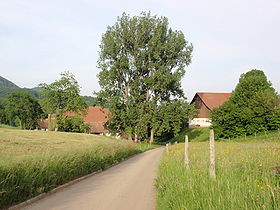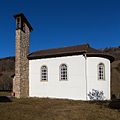Sel people
| Sel people | ||
|---|---|---|
| State : |
|
|
| Canton : |
|
|
| District : | Porrentruy | |
| Municipal municipality : | Clos du Doubs | |
| Postal code : | 2888 | |
| Coordinates : | 575472 / 246347 | |
| Height : | 650 m above sea level M. | |
| Area : | 6.81 km² | |
| Residents: | 72 (December 31, 2007) | |
| Population density : | 11 inhabitants per km² | |
|
Sel people |
||
| map | ||
|
|
||
Seleute ( fc. [ (Ɛ) slœt ]; dt. Schelten ) is a village and a former political municipality in the Porrentruy district of the Swiss canton of Jura .
geography
Seleute is at 650 m above sea level. M. , six kilometers south-southeast of the district capital Porrentruy (air line). The farming village extends on a terrace on the northern slope of the Doubs , around 200 m above the valley floor, in the Chain Jura .
The area of the 6.8 km² former municipal area includes the southern slope of the Lomont Jura range , which is divided by several small erosion valleys and a front terrace. The northern border ran near the ridge (mostly beyond the watershed) via La Gravière ( 857 m above sea level ), La Joratte ( 901 m above sea level ) and reached the Plainmont de Monnat at 902 m above sea level. M. the highest point of the municipality. In the far east, the area extended to the summit of the Sur la Croix pass on the cantonal road from Courgenay to Saint-Ursanne. Seleute owned a larger exclave on the opposite side of the Doubs, in the Clos du Doubs , on the northern slope of the Fin du Teck (up to 800 m above sea level ). In 1997, 2% of the municipal area was accounted for by settlements, 55% for forests and woodlands and 43% for agriculture.
Several individual farms belonged to Seleute. Seleute's neighboring communities were Saint-Ursanne , Montmelon , Epauvillers , Epiquerez , Ocourt and Courgenay .
population
With 72 inhabitants (end of 2007) Seleute is one of the smallest communities in the canton of Jura. 95.5% of the residents are French-speaking and 4.5% German-speaking (as of 2000). Since 1850, the population has decreased by around half, from over 150 at that time. In 1900 there were still 116 inhabitants.
economy
Seleute is a village characterized by agriculture , with cattle breeding and dairy farming predominating alongside some arable and fruit growing . The place hardly offers any jobs outside of the primary sector . The few gainfully employed people who do not work in agriculture mainly work in the valley town of Saint-Ursanne.
traffic
The community is far away from the larger thoroughfares. From the cantonal road that runs from Saint-Ursanne along the course of the Doubs to Saint-Hippolyte (Doubs) in France, there is a spur road up to Seleute. The village has no connection to public transport.
history
The village is first mentioned as Celute in 1180 ; the etymology of the place name is unknown. Seleute was under the principality of Basel . From 1793 to 1815 the village belonged to France and was initially part of the Département du Mont-Terrible , from 1800 it was linked to the Department of Haut-Rhin . Through the decision of the Congress of Vienna , Seleute came to the canton of Bern in 1815 and then to the newly founded canton of Jura on January 1, 1979. On January 1, 2009, the municipality was united with Epauvillers , Epiquerez , Montenol , Montmelon , Ocourt and Saint-Ursanne to form the new municipality of Clos du Doubs .
Attractions
The Notre-Dame-du-Sacré-Cœur chapel was built in 1888 and renovated in 1955. Seleute always belonged to the parish of Saint-Ursanne. The former schoolhouse was built in the 19th century in the neoclassical style.
Web links
- Dominique Prongué: Sel people . In: Historical Lexicon of Switzerland .
- Information about Seleute in Juranet.ch (French)
Individual evidence
- ↑ a b Nicolas Pépin, Seleute JU (Porrentruy) in: Dictionnaire toponymique des communes suisses - Lexicon of Swiss community names - Dizionario toponomastico dei comuni svizzeri (DTS | LSG) , Center de dialectologie, Université de Neuchâtel, Verlag Huber, Frauenfeld / Stuttgart / Vienna 2005, ISBN 3-7193-1308-5 and Éditions Payot, Lausanne 2005, ISBN 2-601-03336-3 , p. 824.







